
Answer [1]: The metal slab becomes "polarized"; its upper surface will become negatively charged and its bottom surface will become positively charged. As a result these surface are attracted the plates. So, in order to remove the slab you would have to do (positive) work, i.e., in putting the slab in place the system does work, i.e., you do negative work. Therefore, the potential between the plates must be lower.
V = Q/C and C = εoA/d,
∴ E = (Q/C)/d = Q/(εoA).
Since Q and A remain the same, E, the electric field remains constant.
Answer [3]: The dielectric becomes polarized when it is between the charged plates. The positively charged surface of the dielectric is attracted to the negative plate of the capacitor and the negatively charged surface of the dielectric is attracted to the positive plate. Thus, you have to do work to remove the dielectric. Therefore, the energy stored increases when the dielectric is removed.
Answer [4]: When the glass slab is inserted it becomes polarized and so the electric field between the plates is reduced. However, since the battery maintains a constant potential difference across the plates, more charge has to be deposited on the plates. Since this requires work to be done, the energy of the system increases.
Answer [5]: Here are two ways of doing it!

Answer [6]: First, we note that the potential difference across the capacitors does not change since the battery remains connected. Inserting a dielectric, like a sheet of paper, will increase the capacitance of Y. Therefore, since the potential across the capacitors remains the same, the energy stored in Y must increase (since U = (1/2)CV2) . Also, since the potential across the capacitors remains the same, but the capacitance of Y increases, then the charge on Y must increase also (since C=Q/V).
Answer [7]: Actually, the capacitance remains constant! Let x be the distance from the upper plate to the slab.
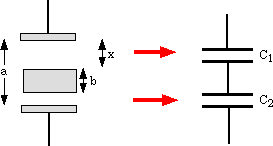
Clearly, the arrangement is equivalent to two capacitors in series. If the plates have area A, the two capacitances are
Therefore, the equivalent capacitance (Ceq) is given by:
= (a - b)/(εoA).
So, the equivalent capacitance is εoA/(a - b), which is independent of x.
Answer [8]: Believe it or believe it not, they all have the same "equivalent" capacitance! Try it ...
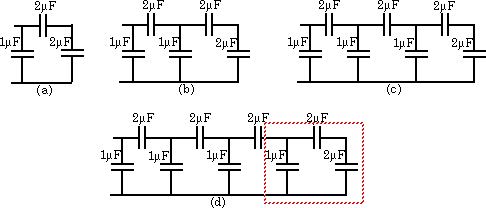
I'll do circuit (d) ...
Starting from the right-hand end, in the "boxed" region the two 2μF are in series, and have an equivalent capacitance of 1μF. In turn, this equivalent capacitance is in parallel with a 1μF capacitor, producing a total equivalent capacitance (for the boxed region) of 2μF. This produces the same arrangement at the "end" of circuit (c). If you do the same for (c), you'll get (b) ... and so on. The equivalent capacitance of all the circuits is, therefore, 2μF!
Answer [9]: This is not as difficult as it might appear! To see what's happening, let's take N = 2, as shown below:

As you can see in (a), when there are 2 plates in each set, the number of capacitors, i.e., sheets of positive and negative charges separated by a distance d/2, is 3, i.e., (2N - 1). But how are these capacitors arranged? Figure (b) is another way of representing the arrangement shown in (a); then we realize that we can re-arrange the layout without changing how the capacitors are connected, and get figure (c). We can see that the capacitors are, in fact, in parallel, so the total capacitance is 3× that of a single component. Therefore, if there are N plates in each set, there are (2N - 1) capacitors in parallel, so the total capacitance is:
Answer [10]: I think of it as energy associated with the electric field produced in the charged capacitor. This electric field can do work - for example, it can apply a force on a charge to make it move - therefore, it has potential energy. If the capacitor is not charged, there is no electric field and no "stored" energy.
If we consider a parallel plate capacitor,
so, the energy stored in the capacitor is:
The "volume" occupied by the electric field in a parallel plate capacitor is A × d, so the energy per unit volume stored in the electric field is:
In fact, this is a general result for the energy density (J/m3) of any electric field.
Answer [11]: The charges on the plates will tend to collect in the region of overlap as shown because of attractive forces. However, some charge in each plate will "spill" into the non-overlap region because of repulsion but the electric field will be much stronger between the plates in the overlap region. So, the distribution of charges and the corresponding electric field will look something like the figure below:
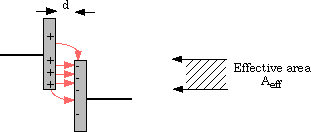
(Remember, electric field lines are perpendicular conducting surfaces like the plates of the capacitor.) Thus, to a first approximation, the electric field is restricted to the region of overlap. So, if we neglect the (small) contribution to the field outside the overlap region, the effective capacitance is:
So, as the overlap increases the capacitance inceases also.
This is the principle of the variable air capacitor shown below:
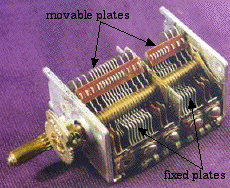
By rotating a knob attached to the shaft, an operator can change the overlap between a set of movable and a set of fixed parallel plates. In that way, the capacitance of the device can be changed to the desired value. This particular capacitor has a total of 47 plates and the capacitance can be varied from zero to a maximum of 430pF. It could be used in an AM/FM radio to enable the operator to tune to the desired radio station.
Answer [12]: Actually, it would require a HUGE capacitance! First, we need to convert 3W.h to the SI unit of energy. We remember that 1Watt.second ⇒ 1 Joule, so that:
Now, the energy stored in a capacitor is (1/2)CV2, so with V = 1.5V, to have the same amount of energy available, we require:
∴ C = 9600 F.
This is a huge capacitance! To give you an idea ... if it were an isolated sphere,
∴ R = C/(4πεo) = 8.63 × 1013m.
and how big is that? ... It's larger than the solar system!! If the spherical capacitor was permitted to have a potential of 10,000V (instead of 1.5V, but then it's not really equivalent to an AA battery!), the required capacitance would be reduced to 216μF; the sphere radius would then be 1.94 × 108m, i.e., about 1/3 the Earth's radius, but still a big capacitor!
Answer [13]: This answer calls for some assumptions! Since people are conductors, we can approximate the scenario to a parallel plate capacitor with a small air gap. The "area" of each "plate" is ~1.8m (tall) × 0.4m (wide), i.e., ~0.7m2. The "average gap" is ~1cm, so an estimate of the capacitance would be:
The most difficult quantity to assess is the gap ... it could conceivably be larger than 1cm. So, 6nF might be on the high side; however, our calculation does at least provide an order of magnitude result.
Answer [14]: The equivalent capacitance of the network of 4 capacitors is C. The two capacitors in the branch AXB are in series, as are the capacitors in the branch AYB.
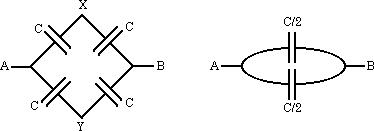
The equivalent capacitance in each case is given by:
∴ Ceq = C/2
So now we have two (equivalent) capacitors in parallel across A-B. The equivalent capacitance of these two capacitors is therefore,
Consequently, the equivalent capacitance of the four capacitors is C.
If a capacitor is connected across X-Y, it makes no difference! Why? ... because, if a potential difference is applied across A-B, symmetry requires that the potential at X is the same as the potential at Y (i.e., 1/2 of what is applied across A-B).
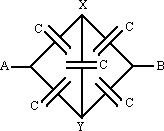
Since there is no potential difference across the "inner" capacitor it has no charge on it. As a result, it has no effect on the charges already existing on the other four capacitors ... so it has no overall effect!